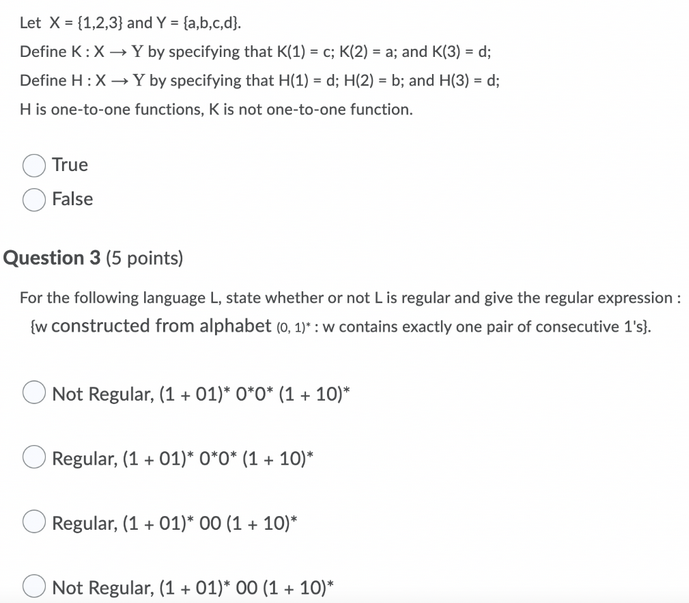Question
Let X = {1,2,3} and Y = {a,b,c,d). Define K: X Y by specifying that K(1) = c; K(2) = a; and K(3) =

Let X = {1,2,3} and Y = {a,b,c,d). Define K: X Y by specifying that K(1) = c; K(2) = a; and K(3) = d; Define H : X Y by specifying that H(1) = d; H(2) = b; and H(3) = d; H is one-to-one functions, K is not one-to-one function. True False Question 3 (5 points) For the following language L, state whether or not L is regular and give the regular expression : {w constructed from alphabet (0, 1)*: w contains exactly one pair of consecutive 1's}. Not Regular, (1 + 01)* 0*0* (1 + 10)* Regular, (1 + 01)* 0*0* (1 + 10)* Regular, (1 +01)* 00 (1 + 10)* Not Regular, (1 +01)* 00 (1 + 10)*
Step by Step Solution
3.39 Rating (158 Votes )
There are 3 Steps involved in it
Step: 1
The detailed answer for the above question is provided below It is true Let X 123 and Y abcd Define K X Y by specifying that K1 c K2 a and K3 d Define H X Y by specifying that H1 d H2 b and H3 d H is ...
Get Instant Access to Expert-Tailored Solutions
See step-by-step solutions with expert insights and AI powered tools for academic success
Step: 2

Step: 3

Ace Your Homework with AI
Get the answers you need in no time with our AI-driven, step-by-step assistance
Get StartedRecommended Textbook for
A First Course in the Finite Element Method
Authors: Daryl L. Logan
6th edition
1305635116, 978-1305887176, 1305887174, 978-1305635111
Students also viewed these Programming questions
Question
Answered: 1 week ago
Question
Answered: 1 week ago
Question
Answered: 1 week ago
Question
Answered: 1 week ago
Question
Answered: 1 week ago
Question
Answered: 1 week ago
Question
Answered: 1 week ago
Question
Answered: 1 week ago
Question
Answered: 1 week ago
Question
Answered: 1 week ago
Question
Answered: 1 week ago
Question
Answered: 1 week ago
Question
Answered: 1 week ago
Question
Answered: 1 week ago
Question
Answered: 1 week ago
Question
Answered: 1 week ago
Question
Answered: 1 week ago
Question
Answered: 1 week ago
Question
Answered: 1 week ago
Question
Answered: 1 week ago
Question
Answered: 1 week ago
Question
Answered: 1 week ago
View Answer in SolutionInn App



